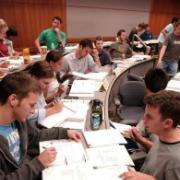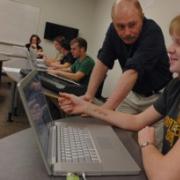What is it?
The flipped classroom is a teaching approach where your students get their first exposure to course content before coming to class through readings and video lectures. They then spend in-class time engaging in activities that you’ve designed to promote a deeper understanding of a concept.
How Does it work?
Record lectures
Take a single module (or lesson), and look at your learning objectives. Order your objectives from simple to complex. Objectives that are simple or at the lower thinking order include those that require your students to remember and demonstrate understanding of these facts. Complex objectives are those that require students to apply, analyze, synthesize, or evaluate concepts. The lower thinking order learning objectives, that students should master before coming to class is the content that you will record and provide to students outside of class. Refer to Bloom’s Taxonomy Action Verbs to help you order your objectives.
Assign lectures as homework
When introducing a new concept, have students watch lectures at home. Each lecture videos should be no more than 10 minutes in length, and cover only one concept. If you cannot cover one topic in ten minutes, break your content into multiple videos. The total length of assigned videos per week should not exceed your weekly lecture time (150 minutes/3 credit course.)
Facilitate engaging learning activities during class time.
Since this is where the learning occurs, planning these activities is the most difficult and time consuming portion of redesigning your course. Planning in-class activities guides students in the acquisition of the most complex objectives for that particular module or lesson. Activities can include: Think-Pair-Share, group work, Jig Saw, and/or problem based learning. More active learning strategies can be found via the Active Learning Continuum chart. Depending on the complexity of the problem, students may not be able to complete activity in one session. Also, you may consider planning out your in class session minute by minute — or at least in 5 minute increments to keep yourself and students on task.
Create assessments that frequently check for understanding.
Assessments can come in all shapes and sizes. While assessments provide a layer of accountability that students are preparing for class by reading the assigned text and watching videos, they also provide indicators for understanding. Short quizzes, 1 minute papers, or past student performance can help you determine where students are struggling and what concepts you will need to provide clarification at the beginning of class.
What are the benefits?
There are many benefits to flipping your class. The success of flipping your class will differ, based on your course needs and objectives. Below are just a handful of possible outcomes and benefits:
Flexible learning. Students can take control of their learning by going at their own pace. They can watch videos as many times as necessary, rewind and stop to take notes, as they work to grasp concepts. Self-tests and short assessments provide an acknowledgement that they’ve mastered the necessary concept and are prepared for the in class discussion.
Flexible model. Flipping the classroom is not an all or nothing approach. You can select what content or portion of your course you choose to flip. Those who don’t flip their entire curriculum generally select a specific day of the week, module, or portion of their course they feel will lend well to the flipped model. Some educators will also use just portions of the flipped model like incorporating active learning strategies during face to face meeting times, or record content they feel is remedial and just cover new material during class time.
Provide prompt feedback. You’re able to provide prompt and timely feedback to students based on their out of class assessment performance. Short assessments that are due before class, such as (auto-graded) quizzes, homework submissions, or 1 minute papers can help to quickly assess where students are struggling, where students are excelling, and what content they’d like to learn more about during the in class session. This strategy may also provide students with the feeling of ownership of the classroom since their feedback is really driving the conversation.
Increased engagement. Since most likely you’ll now be facilitating a conversation during class time, there is an increased engagement between student to instructor. Students, especially those who are in large enrollment courses, have the opportunity to ask questions, request clarification, and receive a greater level of expertise than ever before. Increased engagement. Additionally, students will experience an increased engagement with their peers and the content from your course more than ever before through active learning activities and group work.
Reach more students. The flipped classroom format resonates well with those who are high performers and those who tend to underperform. While high performing students typically come to class prepared – whether the course is flipped or not – these students thrive with the opportunity to apply their knowledge and teach others. Those who tend to underperform – for whatever reason – benefits from the collaborative knowledge of his or her peers and can become more engaged with the material as they contribute to the conversation.
What are the potential downsides?
Change. Change demands a tremendous amount of time and energy. Flipping your classroom is no different. It’s a big upfront investment that can take away from research and other priorities. While the concept of flipping the classroom sounds relatively simple, it’s takes more work that most anticipate – especially planning and aligning the in-class activities with your course objectives and outcomes.
Large Lecture courses. If additional support isn’t available, large enrollment courses can be difficult to flip. In addition to daily classroom management, keeping track of groups and progress may become more of an inordinate task. Also, the amount assessment data that’s collected may become overwhelming. Physical classroom constraints (stadium seating) may also make it difficult for your students to work in groups.
Lack of buy in. While the flipped classroom model benefits students, they may not buy into the idea of having to actively participate during class time. You may have to spend a considerable amount of time coaching and teaching students how to become active learners and work collaboratively in a group setting.
Loss of nuances and context. While short, succinct videos allow you to deliver a lot of information, some feel that it can’t replace a dynamic lecture. Since these videos are meant to deliver just the facts, nuances are often removed and context can be lost. This could impact students who come to CU-Boulder specifically to take classes from noted campus experts. Are we doing these students a disservice by recording lectures and using Open Educational Resources created from other institutions, rather than using a interactive lecture format?
Top 10 Best Practices for Flipping your Class
- Get buy-in from your students. Explain why you’re flipping your classroom, what students can expect, and how this new format can benefit them. You may need to remind them a few times until students get used to it.
- Strategically select what modules or sessions you’d like to flip. Flipping isn’t an all or nothing approach. You can choose to flip just one module or one session per week.
- Well-planned face-to-face time. Take this opportunity to facilitate unique and engaging activities that couldn’t be done out of class. This might include: group competitions, case studies, debates, and problem solving.
- Functional groups don’t happen on its own. Functional groups takes careful planning, well designed activities, and a lot of support from the instructor. Assign group roles for students and explain these roles clearly at the onset of the activity.
- Assess students’ mastery of pre-class material to make the best use of in-class time. Assign low-stakes assessments such as 1-minute papers, online quizzes, or a reflection paper. This can help you quickly identify and correct misconceptions and gaps in student’s mastery of the material.
- The student’s out of class workload should be the same as your traditional course. This includes assigned readings and videos. The length of all required screencasts should be equivalent to your normal lectures (2.5 hours for a three credit class).
- Leverage Open Educational Resources for screencasts, lessons, or readings. Many of these resources are published under a creative commons license and can be adapted to the instructor or student needs.
- Keep screencast videos to less than 10 minutes, covering only a single concept. Brain research tells us that the novelty of any stimulus tends to wear off after about 10 minutes, and as a result, learners tend to check out after 10 minutes of exposure to new content. (Medina, 2008)
- Controlled Chaos. Expect that your classroom will be chaotic. Control the level of chaos by carefully crafting time on task activities and providing students with a time frame.
- Step aside and allow students to learn from each other. Facilitate the learning experience and only intervene only if there is a misunderstanding of a concept or the conversations needs redirection.
What tools do I need to get started?
- Syllabus (or something outlining the learning objectives for a single lesson or module)
- Flipped Classroom Worksheet
- Flipped Resources (Material provided through Flipped Classroom Summer 2014 Workshop)
- Screencasting tool (ASSETT supports Camtasia)
- Access to a D2L course
References
- Arnold-Garza, S. The Flipped Classroom: Assessing an innovative model for effective and engaging library instruction. College & Research Libraries News, 75, 10-13. Retrieved March 14, 2014, from http://crln.acrl.org/content/75/1/10.short?rss=1
- Braxton, J. M., Jones, W. A., Hirschy, A. S., & Hartley, H. V., III. (2008). The role of active learning in college persistence. New Directions for Teaching and Learning, Number 115, 71–83.
- Enfield, J. Looking at the Impact of the Flipped Classroom Model of Instruction on Undergraduate Multimedia Students at CSUN. TechTrends, 57, 14-27. Retrieved March 10, 2014, from http://link.springer.com/article/10.1007%2Fs11528-013-0698-1
- Educause. (2012, February). 7 things you should know about the flipped classroom. Retrieved February 5, 2014 from: http://www.educause.edu/library/resources/7-things-you-should-know-about-flipped-classrooms
- Gaughan, J. The Flipped Classroom in World History. The History Teacher, 47, 221-244. Retrieved March 14, 2014, from http://www.societyforhistoryeducation.org/F14Preview.html
- Goodwin, B., & Miller, K.. Research Says / Evidence on Flipped Classrooms Is Still Coming In. Educational Leadership, 70, 78-80. Retrieved May 28, 2014, from http://www.ascd.org/publications/educational-leadership/mar13/vol70/num06/Evidence-on-Flipped-Classrooms-Is-Still-Coming-In.aspx
- King, A. From Sage on the Stage to Guide on the Side. College Teaching, 41, 30-35. Retrieved March 1, 2014, from http://www.jstor.org/stable/i27558562
- Project Tomorrow Speak up 2013 Report on Overwhelmingly Positive Response to Flipped Learning. Retrieved May 10, 2013 from http://www.tomorrow.org/speakup/pdfs/SU13SurveyResultsFlippedLearning.pdf
- Sams, A., & Bergmann, J. (2013, March). Flip Your Students’ Learning. Retrieved May 1, 2014, from http://www.ascd.org/publications/educational-leadership/mar13/vol70/num06/Flip-Your-Students%27-Learning.aspx
- Tune, J. D., Sturek, M., & Basile, D. P. Flipped classroom model improves graduate student performance in cardiovascular, respiratory, and renal physiology. Advances in Physiology Education, 37, 316-320. Retrieved April 13, 2014, fromhttp://advan.physiology.org/content/37/4/316

